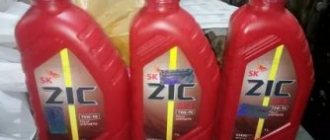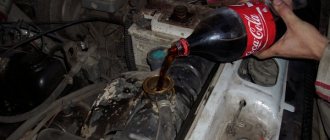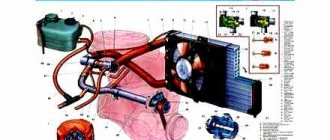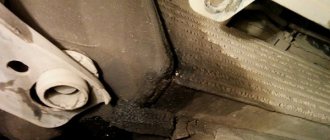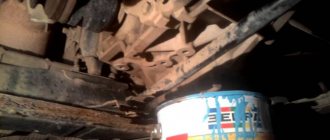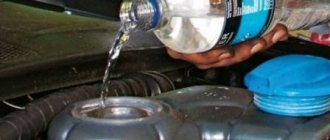Standard oil flush with reduced drain interval
To flush the engine, use regular oil, which is poured into the power unit instead of waste fluid. Then operate the power unit in normal operating mode and perform the next engine fluid change at a reduced interval - this is 3 thousand mileage. After that, the car oil is drained and the same is poured into the engine. It is driven for the full interval regulated by the oil manufacturer.
This flushing method has a clear advantage: a motor mixture with good performance consists of a base base and additives. Additives work effectively for the first few thousand mileage, so they can clean the engine when used in normal operation, without causing any harm to the engine, rubber gaskets, or clogging the internal combustion engine channels.
Among the disadvantages, high cost should be highlighted. This flushing option is quite expensive and requires up to three replacements of the engine mixture and oil filter every 3 thousand kilometers.
Methods for flushing the motor before filling with fresh lubricant
Power units running to the extreme state are subject to disassembly and manual washing. There are flushing liquids for cleaning other starters. Before flushing your engine before changing the oil, there are several methods to consider:
- Diesel fuel. An old method that causes a lot of controversy. After draining the waste, you need to pour 2 liters of diesel fuel into the engine crankcase, wait 5-10 minutes and drain it through the drain hole. After this, it is necessary to prepare a cleaning solution in the ratio of 2 liters of diesel fuel and 2 liters of oil. You can use any inexpensive synthetic oil. The prepared mixture is filled with the engine lubrication system. The engine must be started and allowed to run for 5 minutes.
- Solution for 5 minutes. Sold ready-made. The name of the solution determines the method of its use. The solution is based on fuel diluted with solvents with aggressive additives. Before draining the old lubricant, the solution is poured into the lubrication system. The engine starts and runs for five minutes. According to reviews from car enthusiasts, this method cleans the power plant well, but has a negative effect on the sealing elements.
- Special flushing fluids. They are produced on the basis of mineral lubricants with the addition of cleaning additives. The solution is poured into the lubrication system of the power unit. After filling, you need to drive the car about 100 km and replace the lubricant. The disadvantage of this method is the presence of a residue of the old mixture (about 300 g) in the lubrication system.
- Automotive flushing oil. A special oil solution is used to clean the engine. You can choose any inexpensive brand. It is recommended to clean twice. The first time, you can mix the washing solution with oil in half, pour it into the engine and let it run for 15-20 minutes. Fill the flushing lubricant a second time and drive the car for about 200 km. After this, drain the waste and fill the system with a new oil solution. The advantage of this method is that after draining the waste, lubricant remains in the lubrication system, and not the flushing mass. This preserves the characteristics of the new oil solution.
Flushing mixtures
Flushing oil is poured into the drive after draining the used engine mixture.
It has an increased amount of detergent additives and a high alkaline number, a reduced amount of anti-wear substances. Thanks to this structure, it ensures maximum dissolution of various deposits. The basic basis of such a washing mixture is obtained by hydrocracking from mineral water. You can wash the power unit with it if, after filling it, the engine runs at idle for up to 10 - 15 minutes. Then this engine fluid is drained and the drive is filled with oil recommended by the dealer for viscosity class and performance properties. Its base can be mineral or synthetic.
Manufacturers of car flushing oils claim that their products after flushing (residues remaining in the engine) have a structure that will not change the characteristics of the filled oil for subsequent operation of the engine.
The advantage of this method is the minimal risk of clogging the oil channels and the absence of aggressive interaction of additives with engine elements.
The disadvantage of this method is the price, flushing mixtures are quite expensive, plus after them it is necessary to use motor fluid of the same brand, using a different brand of motor oil can lead to negative consequences, their compositions will react and the resulting oil will not protect the engine from wear and tear sludge formation.
Turbo Cleaner – cleans and unblocks turbines
Turbo Cleaner – cleans and unblocks turbines
Characteristics of Turbo Cleaner – cleans and unblocks turbines
| Package | 12x200ML |
Instructions
Wynn's Turbo Cleaner cleans and unblocks dirty turbochargers. When sprayed, foam is formed, which allows for longer and better “acidification” and cleaning of the turbocharger.
Properties
- Cleans and unlocks turbines both with and without disassembly.
- Dissolves resins, varnish, carbon and other deposits.
- Restores turbine power to its factory parameters.
- Restores the optimal air/fuel ratio.
- Safe for all types of exhaust systems.
Applicability
For all petrol and diesel turbo engines.
Characteristics
Appearance: Transparent liquid
Directions for use
A. Cleaning the turbocharger (intake side) without removing
1. Start and warm up the engine. Remove the flexible hose/sleeve of the intake system located between the air filter and the turbocharger/injector.
2. For gasoline engines, increase the speed to 2000 rpm. For diesel engines - idling only, DO NOT INCREASE RPM.
3. With the engine warm, direct the spray into the air intake manifold.
4. Spray Wynn's Turbo Cleaner at short intervals, avoiding uncontrolled increases in engine speed.
5. After each spray, wait until the speed returns to its previous level.
6. If necessary, increase the speed of the gasoline engine. For diesel engines, never increase the speed.
7. Continue until 200 ml. the product has not been used.
8. Let the engine idle for a few minutes. Turn off the engine. Reinstall the air hose.
9. Start the engine, increase the speed to 3000 rpm maximum, or you need to drive 5-10 km without exceeding 3000 rpm.
10. Let the engine run for another minute before turning off.
B. Cleaning a very dirty turbocharger (inlet and outlet parts) with removal
1. Remove the turbocharger.
2. Disassemble the turbocharger so that the variable geometry impeller is visible.
3. Apply aerosol cleaner to contaminated parts. Leave them with the applied composition for a few minutes
4. Spray the product again until the contamination is completely removed.
5. It is recommended to use a rag or cloth to completely remove dirt.
6. Dry the parts with compressed air or by wiping them dry with a rag or rag. Inspect parts for mechanical defects.
7. Reassemble and reinstall the turbocharging system with new seals.
After cleaning the turbo with or without disassembly using Wynn's Turbo Cleaner, it is advisable to apply the following fuel additives: For gasoline vehicles: Add one bottle of Wynn's Petrol Clean 3 (W29792 or W29793) to the fuel tank after cleaning the turbocharger with Wynn's Turbo Cleaner. Wynn's Petrol Clean 3 will immediately begin cleaning the injectors and combustion chamber, eliminating one of the causes of turbocharger fouling.
For diesel vehicles: Add one bottle of Wynn's Diesel Clean 3 (W12292 or W12293) to the fuel tank after cleaning the turbocharger with Wynn's Turbo Cleaner. Wynn's Diesel Clean 3 will assist in burning off soot on the exhaust side of the turbocharger, resulting in a complete cleaning of the turbocharger on both sides (inlet and outlet).
Packing
No. W28679 – 12×200 ml – EN/FR/DE/ES/IT/NL/RU/EL
Mixtures - “five-minute” and long-acting
“Five-minute” and long-acting mixtures are concentrates with a large amount of detergent additives, which are poured into the old motor fluid before replacement. The motor runs on such a “cocktail” for 10 minutes, in the case of a “five-minute” up to 200 km (when using a long-acting concentrate). Then the mixture is drained and new oil is poured into the engine.
Using “five minutes” you can remove various deposits in a short period. In addition, flushing and changing the oil are performed as one process.
Of the minuses: such reagents can be used to remove small deposits, plus they can aggressively interact with the material from which engine parts, gaskets, and so on are made.
Comparative characteristics by prices and manufacturers (table)
Today's offering on the technical fluids market consists of lubricants of different compositions used for engine flushing. Of course, any manufacturer tries to attract more customers by promising the safety of the motor. In order to understand which engine flush is best to use when changing oil, it is necessary to study the comparative characteristics of certain compositions. According to the data from the table, it can be seen that imported washes are not inferior in quality to domestic ones, but are more expensive in price.
| Name of flushing oil | Performance characteristics | average price |
| Name of flushing oil | Performance characteristics | average price |
| Quick rinse with Liqui Moly allows you to | Cleans the DSV system well, actively acts on accumulated deposits, and polishes the engine walls. | From 18 to 22 cu. e. |
| ZIC flushing | It cleans even heavy accumulations of burning and dirt well. Does not harm oil seals and other seals | About 16 USD e. |
| Eneos technical lubricant | Among other things, it prevents channel blockage. | Approximately 22 USD |
| Flushing Lukoil | A good package of additives that can quite actively remove deposits from the system. | About 14 USD e. |
| Motor flushing TNK | Contains good detergent additives. | Approximately 13 USD e. |
| Motor flushing TNK | Contains good detergent additives. | Approximately 13 USD e. |
| Flushing from Rosneft | It dissolves carbon deposits well and removes all scale products. | About 15 USD e. |
How not to damage the engine?
We need to clarify right away: when changing the engine mixture, you can flush a diesel engine only with the use of special flushing oils.
Do not use products intended for gasoline engines. This recommendation is explained not only by the different structure of deposits formed on engine elements, but also by the fact that for normal operation of a diesel unit, a larger amount of engine mixture is needed in the friction units; the rubbing elements of the engine must “float” in the lubricant. Oil for flushing power units running on gasoline will not be able to provide such an effect. A similar result is obtained when using “five minutes”; they dilute motor fluids too much. Therefore, special detergents are needed to clean a diesel engine. When choosing a flush, keep in mind: if there is a lack of the necessary additives, you can get the engine jammed. Because the main task of washing is to first loosen contaminants and then dissolve them. Loose deposits will not adhere to the surface of the drive elements, they will come off and fall into the crankcase of the power unit, where the engine mixture is taken, then clog the filter, made in the form of a mesh - this will lead to a decrease in the throughput of the oil pump and provoke dry friction in the components motor. A high-quality additive, with the right amount of reagents, can dissolve loose deposits.
What is the best way to flush the engine when changing the oil - expert advice
Often, a vehicle owner is faced with the task of cleaning the power unit before replacing the lubricant. Most often, this is required when purchasing used equipment, when it is not clear under what conditions the car was operated, what condition the engine is in, and what kind of oil was filled previously. However, engine flushing is also required for cars with high mileage, when switching to another type of engine lubricant, when low-quality fuel gets into the engine, and in some other cases. Several methods can be used for cleaning.
Why do you need to flush the power unit?
Long-term operation of a vehicle often leads to the appearance of various types of contaminants that settle on the parts of the power unit and its internal walls.
Important! Regardless of the nature of the deposits, they should not be in the engine. Otherwise, the engine must be washed.
What type of dirt can appear in the engine and what causes its occurrence:
The appearance of contamination can be caused by pouring low-quality oil, difficult operating conditions of the power unit, violation of vehicle maintenance regulations, low quality fuel, etc. They are formed gradually. Removing deposits is one of the functions of high-quality lubrication. But sometimes she cannot cope with this task properly.
Important! It is recommended to regularly flush turbo engines, as they have quite fine tuning.
Understanding that the engine is dirty is not so difficult. It is enough to unscrew the neck cap and examine the insides (sometimes it is necessary to remove the valve cover).
A clean motor does not require any flushing. There is no point in carrying out this event for preventive purposes. You need to understand that a small part of the flushing fluid remains in the lubrication system in any case, worsening the characteristics of the oil that is subsequently filled. And modern lubricants already contain all the necessary additives that are able to remove contaminants formed during operation and ensure normal engine operation. Timely replacement of the lubricant and the use of oil recommended by the vehicle manufacturer will have a much better effect on the operation of the power unit.
If the engine does become dirty, in some cases the owner of the car has to go to a service station and have it sanitized in order to prevent the unit from failing. But often flushing fluids help solve the problem.
Is a turbine really that scary? How to drive correctly with a turbo engine and how much repairs can cost
In our last publication, we already compared turbocharged and naturally aspirated engines, trying to understand what their differences are and which one is better to choose. Let's say that you have already purchased a car with a supercharged engine or are about to buy one.
How is the turbine constructed?
In general, a turbocharger is designed simply. The main part is the cartridge. A shaft is placed inside it, and turbine wheels are attached to this shaft at two opposite ends. In order for the shaft to rotate normally and not heat up, motor oil is supplied to it under pressure. There is also a tube with antifreeze attached to the cartridge for additional cooling.
Attached to the sides of the cartridge body are two “snails” - hot and cold, inside which turbine wheels rotate. The hot exhaust gases enter, spin the wheel, and then “fly away” into the exhaust pipe through the side hole of the cochlea. The turbo wheel in the cold scroll sucks in clean atmospheric air from the intake tract and drives it under strong pressure further into the intake tract to the engine cylinders.
This is the general design of the turbine, and we will not now go into the intricacies of the design and various layout options. However, it is worth mentioning the new generation of turbines, where the oil is supplied under lower pressure, and the shaft rotates in very expensive and heavy-duty ball bearings.
Will the turbine “eat” oil?
As we have already said, a turbine cannot operate without oil. Typically, rubber seals are used to seal rotating shafts (as in an engine and gearbox), but no seals can withstand the operating conditions of a turbine. The operating temperature in it reaches thousands of degrees, and the rotation speed of the shafts reaches hundreds of thousands of revolutions per minute. These are much harsher conditions than in a motor.
The shafts and bushings in the turbine are fitted to each other with very high precision, and due to this, oil should not leak through them if the turbine is working properly. But as soon as the gaps increase, oil is sucked through the “cold” part of the turbine into the engine intake manifold along with the forced air. In such cases they say that “the turbine drives oil.”
Why is this happening?
- Natural wear of the working surfaces of shafts and bushings.
- Reduced oil pressure in the engine: the turbine lacks lubrication and wears out more.
- Increased oil pressure in the engine: oil is simply squeezed out through the cracks between the bushings and shafts.
- Increased vacuum in the intake manifold - oil from the turbine is sucked there. As a result, in engines where the clearances in the cylinders are close to ideal, oil loss due to a faulty turbine can reach several liters per hundred kilometers. This is what supporters of naturally aspirated engines are afraid of.
What is the life of the turbine?
Everything here is very individual and depends on the driving style. On average, on gasoline engines, the turbine life is 150 thousand kilometers. On diesel engines - 250 thousand kilometers. However, if you drive fast, overclocking the engine and turbine, the service life can be reduced to 100 or 60 thousand.
How to understand that the turbine needs to be repaired?
The main sign of the turbine's imminent demise is bluish smoke from the exhaust pipe. Its appearance means that oil is burned in the cylinders along with the air-fuel mixture. It is very likely that this oil entered the intake through the turbine. To carry out diagnostics, you do not need to have a diploma as a car mechanic. It is enough to have a book on the structure of the car, where the location of the components under the hood is drawn, and a little free time.
- Find the inlet pipe through which air enters the turbine and unscrew it. Put your hand into the turbine “scroll” and feel the shaft on which the impeller is attached. Rock it, and if there is play, then oil is probably oozing through the cracks.
- Find the intercooler and look inside. If there is oil inside, then the turbine “drives” it. The more oil, the higher the wear.
Sometimes there are temperature and turbine pressure indicators on the dashboard of turbocharged cars. Accordingly, the temperature should not be elevated and the pressure should not be reduced.
All these tips must be taken into account if you are buying a turbocharged used car. A turbine is an expensive thing, and its defect can result in large expenses for you, as the future owner.
How much does it cost to repair a turbine and what is being repaired in it?
When a turbine fails, there are three options you can take.
Replace the entire turbine. Most often, this is a completely unnecessary undertaking, because the oil drives the cartridge, but the “snail” bodies remain intact and do not need to be changed. Official dealers and multi-brand services like to offer replacement of the complete turbine, the technicians of which have little knowledge of turbines and set the task of getting maximum money from the client.
How much? Removing, disconnecting the oil and antifreeze supply pipes and installing the turbine back costs about 4,000 - 5,000 rubles.
Change the turbine cartridge. The only thing that needs to be replaced is the working element of the turbocharger itself - the housing with the shaft and impellers. Even a technician who does not specialize in turbines can change a finished cartridge. The task is to unscrew several fastening nuts and then screw them back.
How much? The cost of a replacement cartridge is about 15,000 – 20,000 rubles.
Repair the cartridge. This kind of work can only be done by specialized car service technicians. The turbine is completely disassembled, washed with ultrasound, worn elements are identified and replaced. The cartridge body is bored on a lathe, and then the entire structure is balanced in two stages so that there is no vibration at speeds up to 150 - 200 thousand rpm. Then oil is pumped into the cartridge under pressure to check for leaks.
How much? The price of turbine repair depends on a lot of factors and ranges from 7,000 to 25,000 rubles. It is important to understand that if the craftsmen quote a serious amount, then it is often easier to buy a new turbine.
Prices for new and refurbished turbines from different manufacturers
Cost of a new one, rub.
Cost of the restored one, rub.
Cost of analogues, rub.
Volkswagen Passat (1998-2005), Audi A4 (1999-2008), Audi A6 (1998-2005)
Mits u bishi TD04
Volkswagen Crafter, Saab 9-5, Subaru Forester
diesel Ford Mondeo (2007-2014), Ford S-Max (2007-2014)
Please note: automobile concerns almost never develop turbines on their own and most often resort to the help of companies that specialize in this (for example, KKK, Borg Warner or Garrett). At the same time, the same Garrett 760774-5003S turbine under the Ford brand will cost one and a half to two times more than under its own name. The moral is this: before you pay a lot of money for “original” spare parts, find out who supplies them to the manufacturer and order from them.
How should you drive to extend the life of the turbine?
It is clear that the more active you drive, the faster the turbine will become unusable. But, besides this obvious dependence, there are some more useful tips.
- The turbine needs to be cooled. The more actively you stomp on the gas pedal and “burn it out,” the longer it needs to cool. There is no need to open the hood and fan the “snail” with newspaper. Just stand at idle for a couple of minutes - the oil will circulate in the engine and turbine and take away excess heat. In general, make it a rule to drive more slowly before parking.
- After being stuck in traffic for a long time, do not accelerate suddenly. It’s clear that you want to be free after being imprisoned in a traffic jam, but remember: while you were standing motionless, the engine, turbine and intercooler heated up, and if you spin them too much, the heating will be excessive or even critical.
- Monitor the temperature of the oil and antifreeze and change them often. Dirty oil and antifreeze, which does not remove heat well, will accelerate turbine wear.
- Maintain the engine in a timely manner. Here the recommendations will be individual for each model. On modern Volkswagen 1.4 TSI engines, you need to monitor the cleanliness of the intercooler, which quickly becomes dirty, since it is located directly in the intake manifold. On older longitudinally mounted 1.8 TSIs, the oil supply pipe requires regular cleaning...
Each motor has its own nuances. If you want to protect yourself as much as possible from the premature death of the turbine, learn these subtleties from specialists. When buying a new car, the dealership’s technicians will help you, and if you are buying a used one, contact a specialized service station that deals specifically with this brand. It will also be very useful to talk with car service technicians who repair turbines.
Best flushing oil
Today there are many flushing compounds on the market, including those from leading motor oil manufacturers.
Spectrol MOTOR CLEANER
The domestically produced composition carefully cleans the engine of accumulated deposits and waste lubricant residues, and also protects the lubrication system. It is characterized by decent cleaning and anti-corrosion properties.
Advantages of using oil:
PROMO
Flushing from Gazpromneft is intended for cleaning the lubrication systems of engines of passenger cars, commercial and special vehicles running on gasoline and diesel fuel.
The use of this product, thanks to the additives contained in the composition, allows you to remove most high- and low-temperature deposits from the engine. As a result, the oil receiver mesh, oil pan, oil channels and other components and parts of the power unit are cleaned.
Express
Flushing from the Rosneft company is popular with both car owners and service station workers. This oil is produced on a mineral basis with the addition of detergent-dispersant components (the complex was developed jointly by domestic and foreign specialists). The composition is used to clean the lubrication system of gasoline and diesel power units of vehicles of any manufacturer before changing the engine oil.
Express is able to cope even with significant deposits in older engines. At the same time, it does not have a negative effect on the sealing elements.
How to use the oil:
When flushing, all particles contaminating the engine are kept in suspension, which prevents clogging of the oil system channels.
If the motor is very dirty, washing can be repeated.
It should be noted that flushing from Rosneft received official approval from the Volzhsky Automobile Plant.
Lucas AI Innovations
The scope of application of this composition is the flushing of diesel engines exclusively. The demand for the liquid is explained by its good price/quality ratio. After using the oil, noise and the risk of engine overheating are reduced, and the consumption of the fuel mixture is reduced. But it cannot be used in cold weather.
Lukoil Flushing oil
This inexpensive, good quality oil can be used to flush the engines of all brands of cars assembled at AvtoVAZ and foreign cars whose assembly lines are located in Russia.
The composition, made on a mineral base, is reinforced with additives (ZDDP to minimize wear, calcium, which neutralizes the acidic environment from mining and some others). As a result, the liquid received good cleaning, anti-wear and anti-corrosion properties. The oil can be used to clean the lubrication systems of gasoline and diesel engines without disassembling them. Using the composition helps to effectively remove contaminants from the engine within a short period of time.
Advantages of using this brand of washing:
Eneos Flush
The oil is suitable for flushing gasoline and diesel engines of domestic and foreign vehicles. It has excellent cleaning properties. All deposits are kept in suspension, which prevents the channels from clogging.
However, the cost of the liquid cannot be called affordable (although most of those who have tried it in practice consider the high price to be fully consistent with the effect of its use). It is not recommended to pour the composition into very old engines. Another aspect that scares many people is the large number of fakes on the market.
What is better for the engine: using flushing oil or washing for five minutes
The main question that car owners have is what is better: a 5-minute engine flush or a full engine maintenance.
According to the principle of its operation, the five-minute engine is poured into testing and driven during testing at high speeds. But you need to understand that such washing is very aggressive in its composition, moreover, it washes the power unit during testing, which does not always effectively affect the process. You must also strictly adhere to the manufacturer’s recommendations. If it is indicated that the motor should not run for more than 5 minutes on a five-minute cycle, then this must be observed.
It is worth clarifying once again that this is a highly aggressive environment, and ignoring the recommendation may cost the life of the motor. When washing the engine for 5 minutes, the composition cannot be left in the power unit. It is also necessary to remember that 10-15% of the aggressive five-minute treatment, coupled with the working out, remains in the engine and is mixed with the engine’s fresh composition. Which, in theory, negates the entire flushing procedure, because, as a rule, the main carbon deposits sink into the lower layers of the oil and, if it is not completely drained, it will remain inside the system.
Adherents of the five-minute program risk not only being left with a poorly washed unit, but also wasting money and time.
How to properly flush the engine with diesel fuel before changing the oil
Proper engine care is one of the most important tasks in car maintenance. Every owner who is attentive to his car knows that the performance of the car as a whole depends on the quality of service and functionality of the engine. Many car owners, when the time for scheduled maintenance of the car approaches, drive it to a service center, where specialists carry out all the necessary procedures in accordance with the regulations, however, there are also those who prefer to carry out simple service work on their own. In this article we will talk about the procedure for flushing the engine when changing the oil, the need for which has some controversy regarding the frequency of such a process and the type of flushing fluid. Let's consider whether flushing the engine with diesel fuel before changing the oil, which was used in ancient times and remains relevant today, is justified, let's talk about the advantages and disadvantages of this method of dealing with deposits in the power unit, and also tell you how to correctly carry out this procedure.
Why do you need to flush the engine with diesel fuel?
The fact that it is necessary to change the engine oil according to the regulations is known to all car owners; it is explained by the loss of the lubricant’s protective properties during operation and a decrease in the efficiency of its operation. Many articles have been written about the regulations and the need to change the lubricant in the engine, however, it is rarely mentioned that before adding new lubricant it is necessary to wash the unit from the inside. How do professionals explain this need, and how often should the procedure be performed?
The need to flush the power unit arises in the following situations:
These precedents necessitate mandatory flushing of the power unit. In addition, flushing the engine may be necessary if the car is operated in extreme or difficult conditions, high-speed and high-temperature conditions, which provokes the formation of scale on the internal surfaces of the unit, which blocks the oil passages. You can determine the need to flush the engine by inspecting the drained liquid: if there are large particles, flakes and sludge in the waste, you will need to clean the engine from the inside in order to remove components that are dangerous to the engine.
Nowadays, service center employees recommend flushing with special liquids that are designed to clean the power unit before changing the oil. Why then did the question of flushing with diesel fuel arise? Several decades ago, the number of cars on the country’s roads was much smaller, and not every family could boast of a personal car, and accordingly, the range of fluids for servicing the engine was limited to several types of oils and diesel fuel as a means for washing it. Today the market situation has changed, but the habit remains. Many car owners still wash their engines with diesel fuel themselves and recommend this procedure to others. Moreover, some explain this fact by savings, while others indicate the high efficiency of diesel fuel as a flushing liquid.
Today, the theory about the high usefulness and quality of engine flushing with diesel fuel has both adherents and opponents, and in almost equal quantities, which forces car owners to understand for themselves the pros and cons of such a procedure, and as a result, make an independent decision in favor of a flush emulsion - choose a modern liquid or give preference to diesel fuel.
When is flushing needed?
The main goal is to get rid of the remnants of used lubricant before filling in a new one. In some cases, it is actually advisable to flush the engine.
- Changing the engine oil manufacturer, because Not all materials can be mixed with others. For example, you purchased a used car and do not know what petroleum product the previous owner used. There is a possibility that the quality of the oil was not proper. In such a situation, cleaning is necessary, but gentle. Do it this way: fill in with fresh consumables, and when the vehicle’s mileage reaches 500 km, repeat the procedure.
- You simply decided to change the working medium - switch from synthetics to mineral lubricant or vice versa, or there was a need to use a lubricant of a different viscosity - take a summer one instead of a winter one or replace it with an all-season one. It is also better to clean it, although this is not a mandatory operation.
- The vehicle has a long service life, during which it has accumulated a lot of impurities in the form of soot and deposits. In this case, it is optimal to carry out the procedure by removing the pan.
- The car is new, purchased from a dealership, and your goal is to protect your iron horse from deposits for the entire period of use.
- There was serious interference with the engine, for example, a complete overhaul was carried out.
- The cleaning procedure is advisable after accidents, when fuel or cooling material leaks into the sump and you are forced to add lubricant that is not of the highest level.
- With a turbocharged internal combustion engine and with active wear of the car, it is also recommended to flush it.
Pros and cons of diesel fuel as a flushing fluid
Indeed, one of the advantages of diesel fuel in comparison with special means is the pricing policy. Flushing the engine with diesel fuel before changing the oil will be much cheaper than carrying out this procedure using purchased emulsions. The second argument in favor of diesel fuel is its use in all CIS countries for cleaning engines of domestically produced equipment, as well as its applicability for engines of special equipment. The effectiveness of this method is proven by the large number of domestically produced cars on the roads at the present time, which perfectly perform their functions despite their advanced age.
But the following fact casts doubt on the benefits of diesel fuel for the engine. Many users explain the effectiveness of diesel fuel when flushing the engine before changing the oil by the fact that it is actively used to clean engine elements during major repairs by professionals. And this is true, diesel fuel actively cleanses the elements of scale, dirt and sludge. However, opponents of the theory argue that when cleaning parts during a major overhaul, these components are not only affected by diesel fuel, but also a significant mechanical force is applied, due to which a positive result is achieved.
In addition, many experts note that when flushing the engine, diesel fuel does not break down the scale on the parts, but acts by peeling it off from the internal surfaces. Since it is almost impossible to completely remove these particles during the washing process, some of the coarse components will remain in the engine, and when oil is added, the particles will freely circulate through the system, causing damage to it and blocking small passages, thereby causing oil starvation of individual engine components. Additionally, doubts about the effectiveness of diesel fuel in cleaning the power unit are caused by the effect of the liquid on oil seals, gaskets and seals. Diesel fuel can cause their deformation, which will affect not only the functionality of the motor, but also its performance characteristics, and can cause its premature failure.
Other available methods for flushing the injector and engine power system
As you can see, the solvent is an effective cleaner. However, there are other ways to flush injectors.
If you pour such a flush into an old car, the risk that all deposits from the fuel system will clog the channels, dirt will get into the combustion chamber in the cylinders, etc., increases significantly. As a result, the injectors, pump and the engine itself will suffer.
The remaining parts of the fuel system are thoroughly cleaned before installation. This method is the most effective and also guarantees that loose dirt will not get into the cylinders. At the same time, diagnostics allows you to accurately identify faulty injectors, and not just dirty ones.
However, the result may still be worse compared to washing on a bench. You also need to be able to disassemble a diesel injector, and during reassembly, prevent even the slightest particles of dust or dirt from getting in. If this happens, there is a risk of rapid failure of the entire element.
The process of flushing the engine with diesel fuel
If, after weighing all the pros and cons, you decide to clean the engine with diesel fuel, you trust more in the experience of your ancestors, which has proven its effectiveness over the years, than in modern liquids, we will tell you how to carry out this procedure correctly and correctly. The methodology for flushing the engine with diesel fuel when changing the oil is not particularly complicated or requires significant investment. To complete this task, you will need to stock up on diesel fuel, in a volume of at least eight liters, two oil filters, one of which must be of high quality, preferably an original element for your car, the other can be the cheapest, since it will only be used when cleaning the power unit.
The procedure is carried out immediately after draining the used oil. It is recommended to drain the waste in a pit or overpass, on a warm engine, through the oil drain hole on the crankcase pan. Sometimes this will require removing the power unit protection, if it is provided by the vehicle modification. Detailed instructions for changing the fluid in the power unit for a specific car model can be found in the user manual or in articles on this topic on our website. After draining the used motor oil, you need to dismantle the worn-out oil filter and install a purchased filter element in its place.
The further task of the performer is to flush the engine as much as possible from dirt and sludge. To do this, the engine is first cleaned of coarse particles and oil residues by passing diesel fuel through the system. The oil drain hole is left open, and diesel fuel is poured into the filler opening with maximum pressure. It is important to first place a container for the waste liquid under the drain hole. To complete this procedure, you will need about three liters of liquid.
The next step is a better cleaning of the unit components and hard-to-reach areas. For this purpose, the drain opening is closed and diesel fuel is poured in in a volume equal to the amount of motor oil in the car engine. Next, you need to start the car and drive the flushing emulsion through the system, maintaining speed, but without bringing the power unit to operating temperatures. This point is very important, since at high speeds diesel fuel will not be able to cope with the assigned tasks, causing harm to the contacting parts.
After this procedure, the flushing liquid is drained, and the quality of the flowing emulsion is visually monitored. If the diesel fuel comes out too contaminated, with particles of sludge, it is important to carry out this procedure again. Flushing should be carried out until clean fuel begins to flow out of the drain hole, without any impurities in it. At this stage, engine flushing can be considered complete. Next, you should replace the temporary oil filter with a new, original product, tighten the drain cap tightly, having previously cleaned it of dirt and accumulations, and, if necessary, change the seal between the opening and the plug, if it is provided for by the design. The final stage is pouring new motor oil into the vehicle engine. After replacing the lubricating emulsion, it is important to break in the engine - drive the car for about five kilometers in a quiet mode, check the oil level again, if necessary, add it to the level, inspect the butt joints for lubricant leaks.
Since diesel fuel does not have sufficient cleaning and lubricating properties, which are required for the normal functioning of the engine, for the first few kilometers, until the oil is distributed evenly among the components, it is important not to operate the vehicle in an aggressive mode. To eliminate the danger of abrasion of contacting elements, some car owners recommend flushing the engine not with pure diesel fuel, but diluted in equal proportions with inexpensive motor oil, however, the feasibility of such a procedure has not been proven.
How to wash the engine with diesel fuel or kerosene
In the event that you nevertheless decide to wash the power unit with diesel fuel, then it should be noted that this procedure is not complicated. Flushing the engine with diesel fuel before changing the oil is carried out as follows:
- It is necessary to prepare about 5-6 liters of pure diesel fuel/kerosene without impurities;
- Purchase 2 oil filters (one may be the cheapest);
- The engine warms up until it reaches operating temperatures;
- The used engine oil is drained and the old oil filter is removed;
- Next, you should fill in kerosene or diesel fuel, install a new (cheap) oil system filter;
- Then the engine should be started for a couple of minutes, slightly accelerated at idle to medium speed;
- Now you can turn off the car, since warming up the engine above 40-50 degrees with diesel fuel poured into the lubrication system is not allowed.
- After the internal combustion engine has cooled, the engine is started again and the procedure is repeated;
- Next, you can drain the diesel fuel, replace the oil filter and add fresh engine oil;
This is interesting: On the road, the traffic police inspector took a photo of my driver’s license. Does he have the right to do this and why did he do it?
Now let's look at the procedure in more detail. Note that some drivers do not fill the engine with pure kerosene or diesel fuel, but additionally dilute the cleaner with fresh engine oil. In this case, you will need to prepare 2-3 liters of affordable mineral water.
- Before draining used oil from the engine, it is necessary to either prepare a pan of increased capacity or have spare pans. The fact is that after draining the flush, as well as a number of additional manipulations, in general, twice as much liquid (old oil and flushing) will drain from the unit.
- After draining the “working off”, it is recommended not to screw in the drain plug, but to pour several liters of diesel fuel through the engine. The flush must be poured into the oil filler neck sharply so that the diesel fuel passes through the unit under a certain pressure and washes away the remaining engine oil. To do this you will need 2-3 liters of kerosene. After this, you can screw in the drain plug, after which diesel fuel is poured into the engine in a volume that almost reaches the “max” indicator on the dipstick.
After draining the flush, replacing the oil filter and adding fresh oil, you need to take into account that the engine may be difficult to start. The fact is that diesel fuel washes away the oil film and also does not have sufficient lubricating properties. As a result, it is difficult for the starter to turn the crankshaft. After starting the unit, you need to let the engine run for some time at idle speed. At the same time, you need to listen to the operation of the engine, to exclude the occurrence of extraneous noise, knocking or other suspicious sounds. After this, you can start using the car as usual.
Let's sum it up
Diesel oil has been used by car owners for many decades as an effective and gentle means for washing the power unit. Today, the effectiveness of the diesel fuel flushing procedure is questioned by many automakers and service center employees; alternatives are considered to be the use of specific liquids to clean the engine. However, a detailed study of the composition of special emulsions for washing the engine raises doubts and controversial issues, since effective removal of soot and dirt using special liquids is achieved due to the presence of aggressive chemical components in them, which can also negatively affect the unit components.
As many years of practice have proven, the method of flushing the engine with diesel fuel has a right to exist, is characterized by high efficiency against the backdrop of low costs, and is considered a gentle way to clean the engine. Each car owner has the right to decide independently which product to choose; however, when performing the flushing, you should act very carefully, follow the instructions, do not overheat the engine - and the result will live up to expectations. Better yet, keep an eye on the engine of your car, try to avoid overheating and stress, change the oil in a timely manner - and the engine will not need such procedures.
Source
